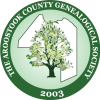– By Richard Kimball
An interesting quirk had me confused for a while. Some of my Ruee ancestors lived in New Castle, New Hampshire and vicinity for about 70 years beginning around 1860. I’ve been trying to track all their various real estate transactions over that period. At first there were several deeds transferring property from non-Ruees to Ruees; these were followed mainly by deeds transferring property from Ruees to Ruees; and finally, as they moved out of that area, married or died, there are several deeds from Ruees to non-Ruees. Some of the deeds involved splitting a property, the houses, gardens and out buildings into two right down the center of the house etc. This required rights-of-way through the front door and central hallways and in one case the owner of the Northeast half of a house had a right-of-way to the cellar stairs which were in the Southwest corner of the house and then across the cellar to that part which lay under his part of the house. He also had a right of way to the cistern in the cellar which allowed him to draw water from it either by bucket or by pipe. While this may seem overly litigious and hint of on-going dispute, this was apparently not the case.
One of these transactions seemed to involve two similar houses across the street from one another. John Henry Ruee sold his half-house and property, which he had originally bought along with some adjoining property in 1862 from his father for $200 to the U. S. Government in 1902 for $1943.46 as they needed it for part of a Coast Guard station.. At the same time, his sister, Mary Caroline (Ruee) Pridham sold the hother half of the house and property which she had to the U. S. Government for $1943.46! I can’t find the deed that records her purchase of the property from either her father or brother, but if it was similar to most of the other in-family transactions, it would have been for $1.00.
Now what makes this quirky is that apparently John Henry Ruee then bought the house (not the property it was on) back from the U. S. Government and had it moved across the street where he and his sister continued their arrangement of each owning half the house, etc. I suspect that the U. S. Government was just planning to tear it down and moving it across the street in those days was fairly easy.
The online deeds don’t seem to be quite complete but I’m seeking information from current owners of what I believe to be the actual house, which still stands and is quite substantial.
Please continue your thoughts on what we might do differently at the NM Agricultural Fair next year. I’ve heard from Frances Heales with some suggestions that sound intriguing. For one, since we did not seem to get much response on our local Who-do-you-thing-you-are, we might take a look at some variations, such as older local houses and track their occupants. Something like this has been done by William J. Tasker in his “Pioneer Homes of Presque Isle including Maysville” published in November 2007. My own home is included in it. We might take this further in some way of community interest and involvement. This also seems like a grand opportunity for a shared project with the historical societies.

